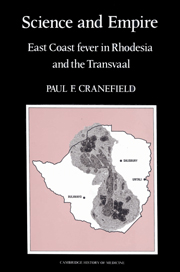Book contents
- Frontmatter
- Contents
- List of illustrations
- Preface
- Acknowledgments
- 1 Prologue
- 2 The places and the players
- 3 A new disease?
- 4 The search for an expert
- 5 Robert Koch in Bulawayo
- 6 Joseph Chamberlain
- 7 Arnold Theiler, Charles Lounsbury and Duncan Hutcheon
- 8 The fight against East Coast fever
- 9 The African-owned cattle in Rhodesia
- 10 Two more parasites and another new disease
- 11 What is East Coast fever?
- 12 Epilogue
- Notes and references
- Index
7 - Arnold Theiler, Charles Lounsbury and Duncan Hutcheon
Published online by Cambridge University Press: 19 January 2010
- Frontmatter
- Contents
- List of illustrations
- Preface
- Acknowledgments
- 1 Prologue
- 2 The places and the players
- 3 A new disease?
- 4 The search for an expert
- 5 Robert Koch in Bulawayo
- 6 Joseph Chamberlain
- 7 Arnold Theiler, Charles Lounsbury and Duncan Hutcheon
- 8 The fight against East Coast fever
- 9 The African-owned cattle in Rhodesia
- 10 Two more parasites and another new disease
- 11 What is East Coast fever?
- 12 Epilogue
- Notes and references
- Index
Summary
During a time when figures of great international reputation such as Laveran and Nocard were claiming that the new disease was only a form of redwater, and while Koch was claiming that the disease, though new, was transmitted by the blue tick and that he had found a way to immunize against it, two young men who were hardly known outside of South Africa were at work establishing the facts. They were the Swiss-born veterinarian Arnold Theiler and the American-born entomologist Charles Lounsbury; both worked closely with and had the strong support of the senior veterinarian of South Africa, Duncan Hutcheon.
Arnold Theiler
Arnold Theiler was born in Switzerland on March 26, 1867 and obtained his diploma as a veterinarian in Zurich in 1889. He found little work in Switzerland and decided to go to the Transvaal, where he arrived in March, 1891, in time to celebrate his twenty-fourth birthday. While working as “supervisor of cattle and forage” on a large farm, he lost his left hand in a farm-machinery accident; thus handicapped, he set up a private practice in Pretoria in September, 1891. That practice was so unsuccessful that Theiler was unable to send Christmas gifts to his family in Switzerland and was reduced to advertising a proprietary cure for horse sickness (for which there was and is no cure).
- Type
- Chapter
- Information
- Science and EmpireEast Coast Fever in Rhodesia and the Transvaal, pp. 137 - 180Publisher: Cambridge University PressPrint publication year: 1991



